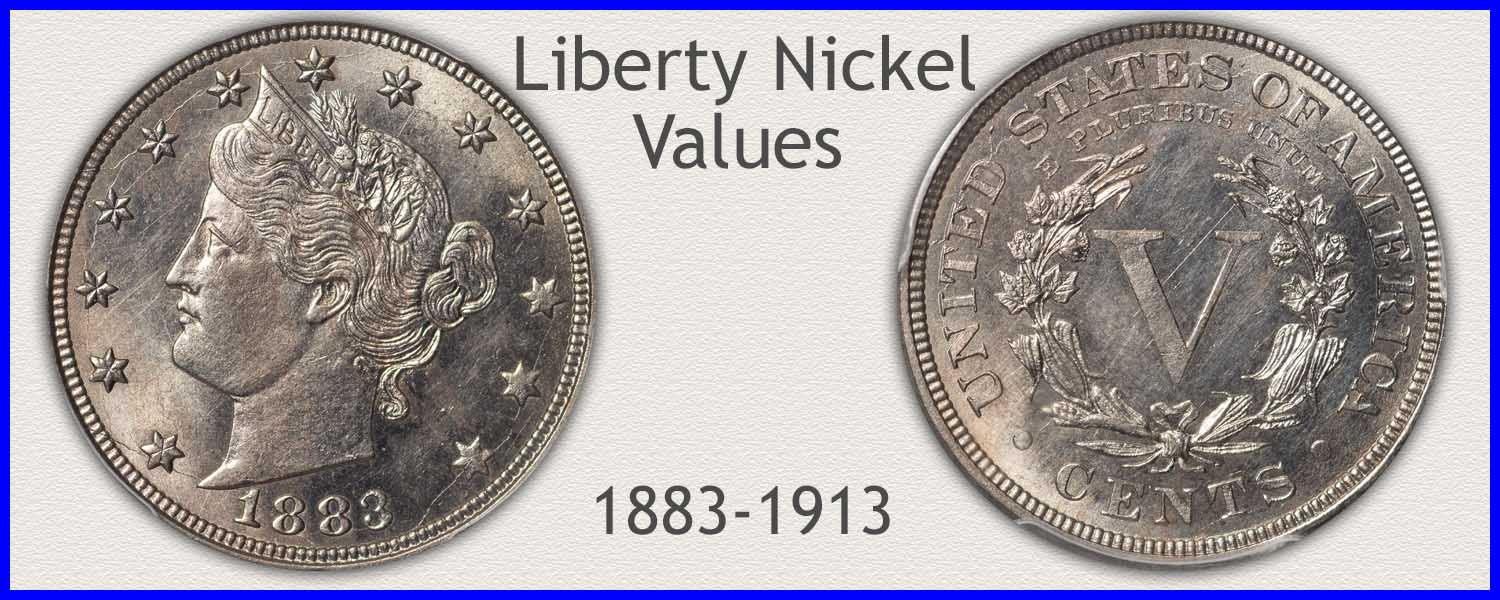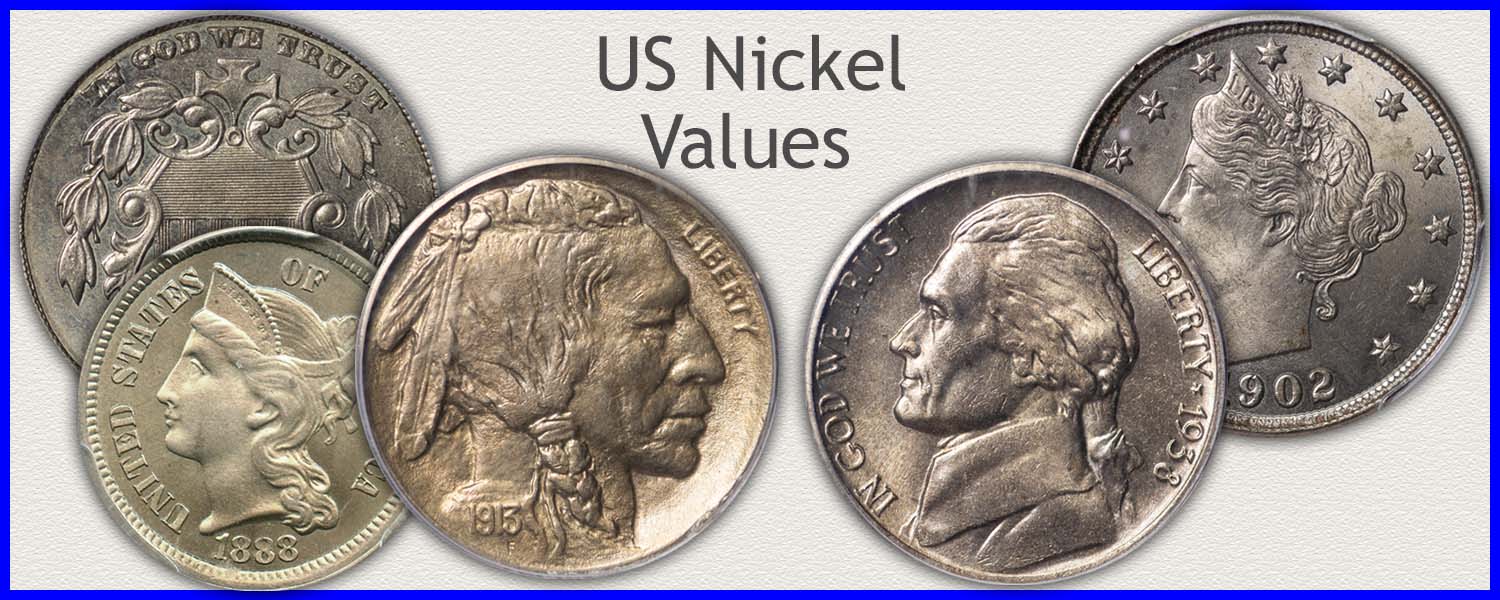Coin Values Moving with Precious Metals: Up-Dated 12/15/2025: Gold $4341 | Silver $63.26
1889 Nickel Value
Always start by confirming the series and date when determining 1889 nickel value. The Liberty design series of nickels is now a very old part of U.S. coinage. In particular, those from the 1880s are now becoming elusive, as seen on the value chart. Following the steps below, all key elements to an accurate identity of the coin, along with its condition, are the main features to recognize.
Follow with a review of potential special qualities, often a large part of their appeal to the collector market. Pleasing qualities are often subtle in how they appear on coins.
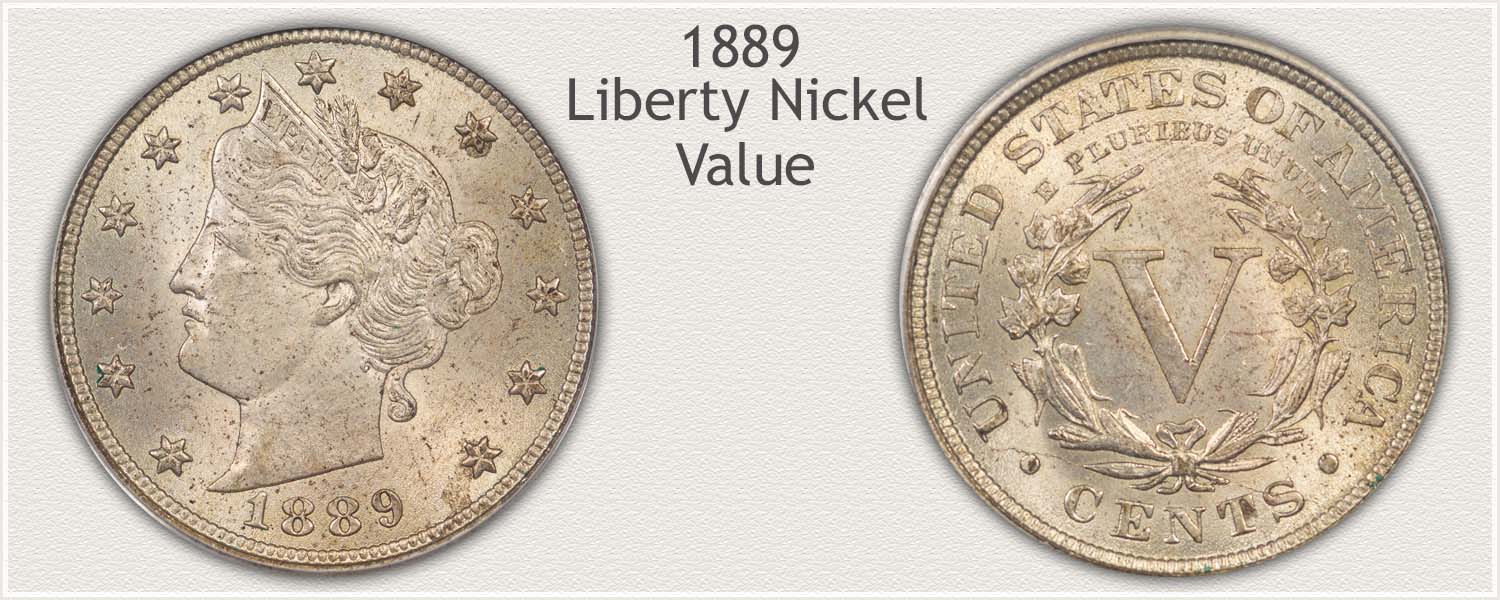
Steps Leading to Value:
- Step 1: Date Identified - Confirm and note this somewhat elusive date Liberty nickel. An important year within the series.
- Step 2: Grading Condition - Condition of the surface is carefully examined. Remaining detail in the design places the coin in specific "grade" categories.
- Step 3: Special Qualities - Pleasing qualities are recognized by the market as strengthening overall value. These qualities appear on the coin in any condition, adding appeal to collectors.
| 1889 Nickel Value | ||||
|---|---|---|---|---|
| Condition of Coin | ||||
| Date | Good | Fine | Extremely Fine |
Mint State |
| Liberty Nickel Value Updated | 2024 | |||
| 1889 | $10 | $24 | $64 | $131 |
Wholesale values are listed on the chart. Use the chart as a guide, demand, and dealer needs for Liberty nickels influence values up or down into a range.
Step 1: | An Important Date to Confirm
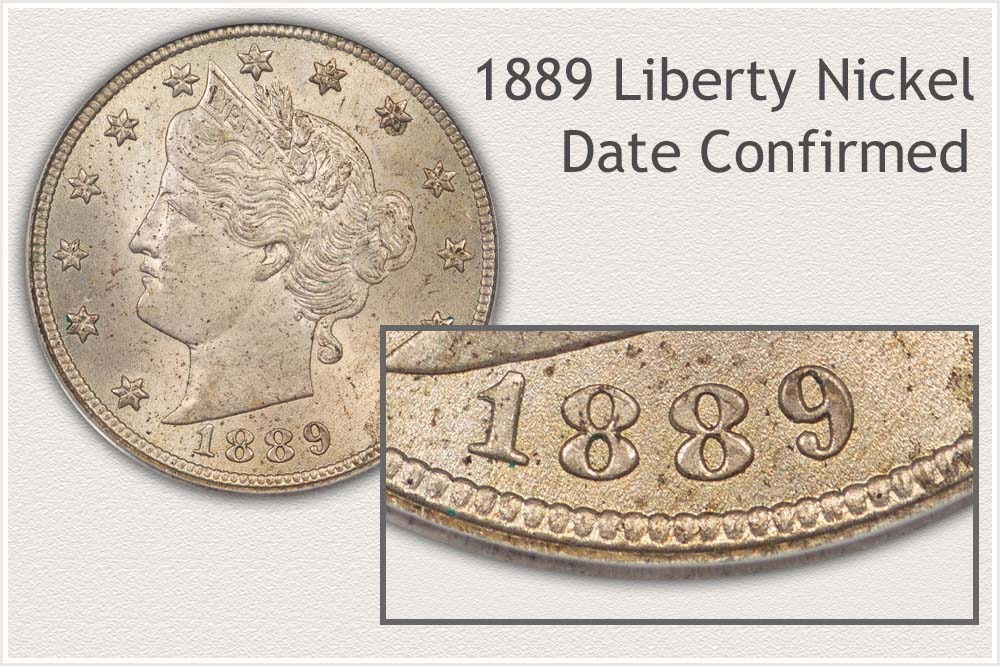
Despite ample production of these 1889 nickels, there is a noted lack of supply today. Philadelphia, the main U.S. mint, released over 15 million into circulation. However, as listed on the chart, a well-worn example is worth a strong premium. Market demand for the date in all conditions supports a strong base worth.
Double check the date, 1889. Similarities between the "9" and "8" digits are close due to the style of the numbers.
Step 2: | Condition Closely Inspected to Define Grade
Significant Value Rise with Improving Visible Detail
All the different values of 1889 nickels are based on their current condition. The different stages of appearance due to wear and abrasions are categorized into specific "grades." These grades are then used by the coin market as part of the description of each coin. Top quality nickels are in Mint State grade, and as wear begins to remove metal, lower grades apply.
Refer to the images, representing the grade stages, and follow the descriptions of each. Matching a coin to these categories begins to narrow its condition into a standard grade.
Mint State Grade
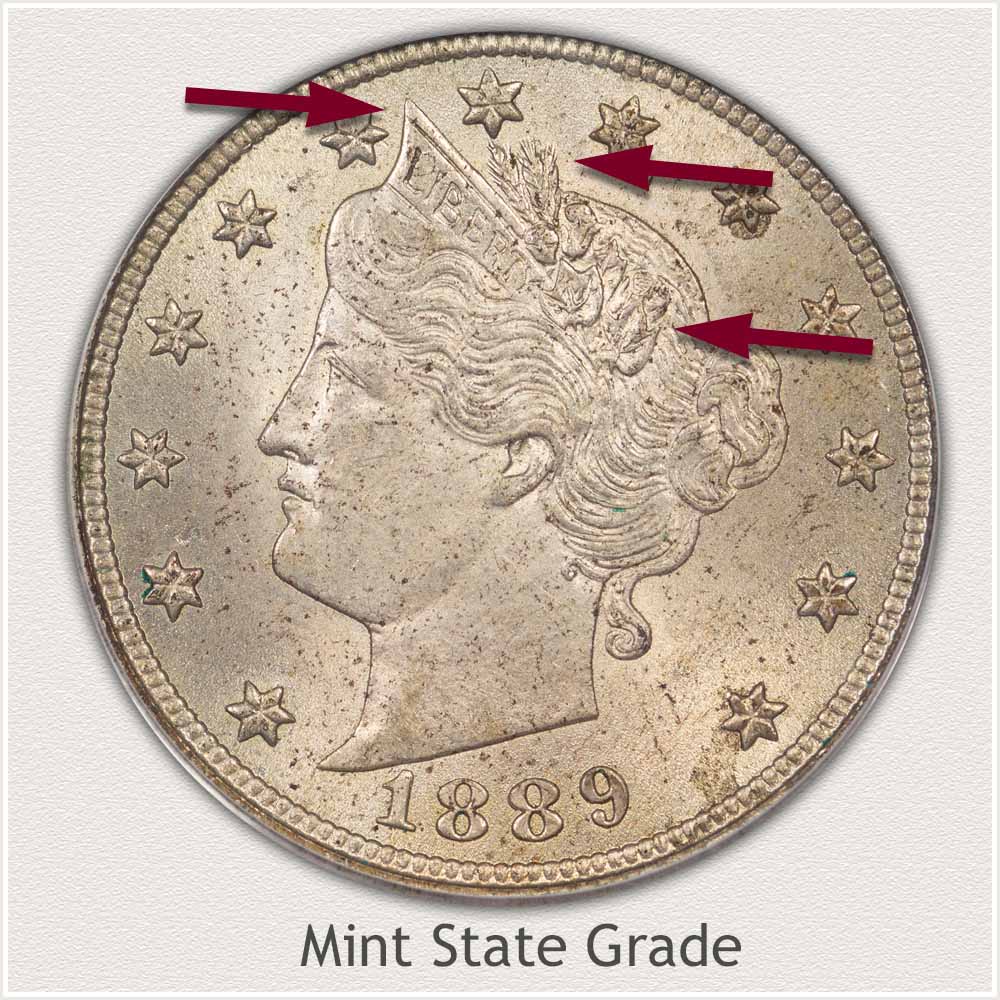
Mint State: Absence of wear to the surface is the defining factor to confirm before awarding the Mint State grade. These nickels have preserved the original luster, fully intact high relief points, and recesses, as well as no wear to the fields of the coin.
Original luster is inspected first. This luster radiates as a shine, flowing across the surface as the coin is turned and tilted under a light. A fine texture to the metal, which causes luster to shine, is the result of striking a nickel under high pressure during the minting process. Using the technique of tilting the coin under a light, wear is detected by dull areas, with Liberty's eye brow and cheek showing dullness first.
Small high points of the design, such as contours at the top of design features, are next to judge. Any wear quickly removes the roundness of contours and dulls the original silvery-gray color of the metal to a dull tone. The very top of the headband, the nearby grains of wheat, and edges of the leaves in the wreath are closely examined. With intact surfaces, no dulling or smoothness is visible, a grade of Mint State is recognized.
Extremely Fine Grade
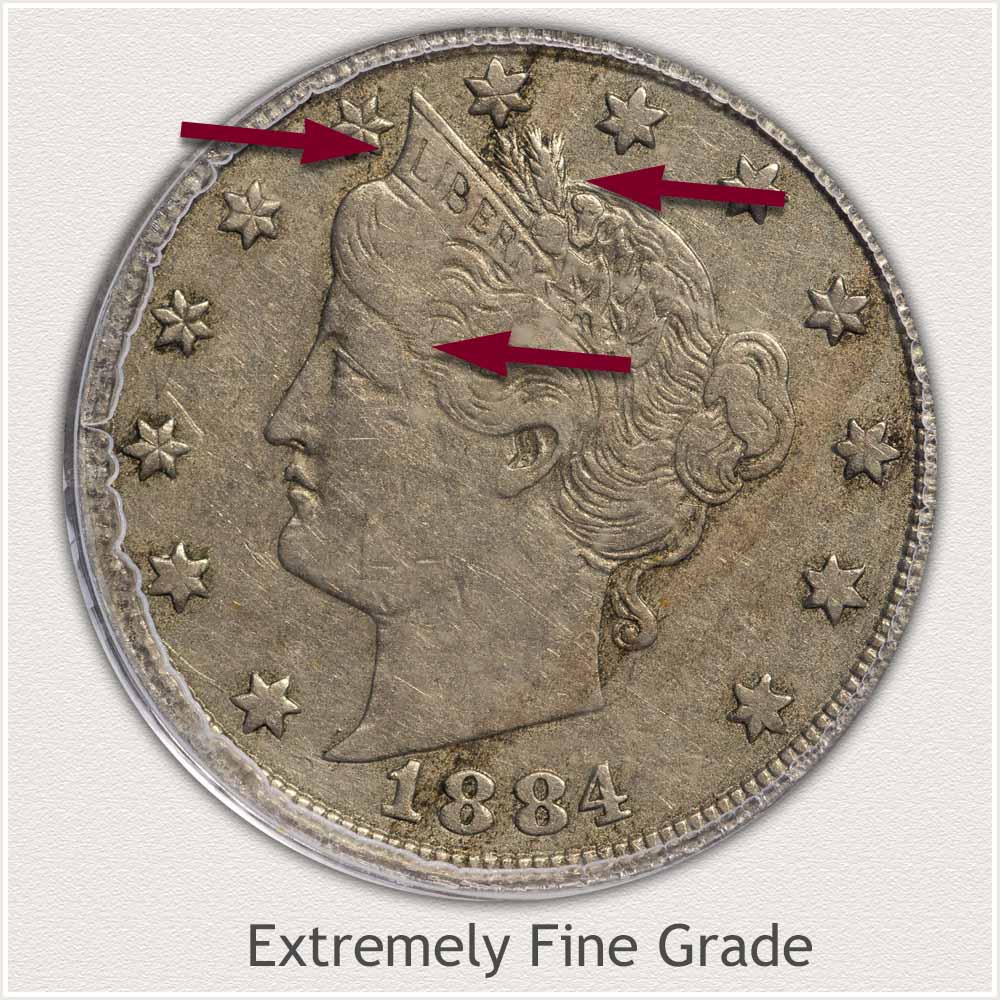
Extremely Fine: 1889 nickels displaying only light wear are well within the higher quality range of those available. An important part of the definition of the Extremely Fine grade is light wear and minimal smoothing to the surface.
What is noticeable on the example nickel is the very slight blending of hair strands within the waves of hair. The critical factor is each area of flatness is small and confined. There is no merging of one flat area into the next.
Helping to identify and judge the grade, visible and recognizable details must include a line defining Liberty's hair above the forehead, complete to her ear. Secondly, within the headband, "Liberty" remains bold. A well detailed wreath of wheat grains and cotton leaves is located above the lettered headband. Combining Liberty's headband with full lettering and bold hair detail throughout her portrait presents a sharp appearance.
Fine Grade
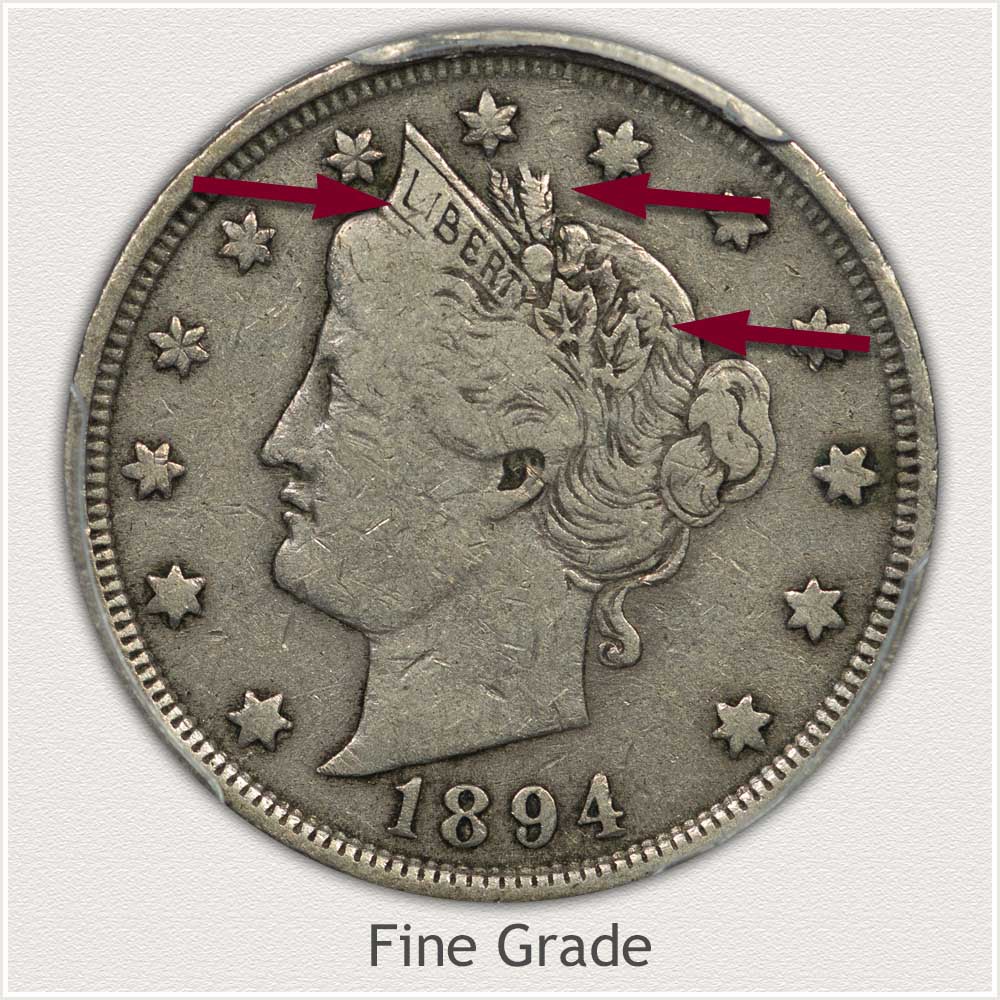
Fine Grade: Once a Liberty nickel wears to the point many areas of the design are merging, the condition is considered Fine grade. Moderate reduction in sharpness leaves only partial indications of hair strands and hair wave details. Visible hair waves towards the back of her head are required to hold this coin within the Fine grade category.
Looking closely at the wreath details above the headband, flatness is pronounced on leaf edges and the two spikes of wheat grains. It is the full separation of the leaves and their design features from the hair that is important to the condition.
Confirming the Fine grade, all letters to "Liberty" are visible. Completeness of the letters is a significant requirement. Although the "I" is often less bold, it remains visible from top to bottom. This coin is a popular condition with many collectors of early era Liberty nickels.
Good Grade
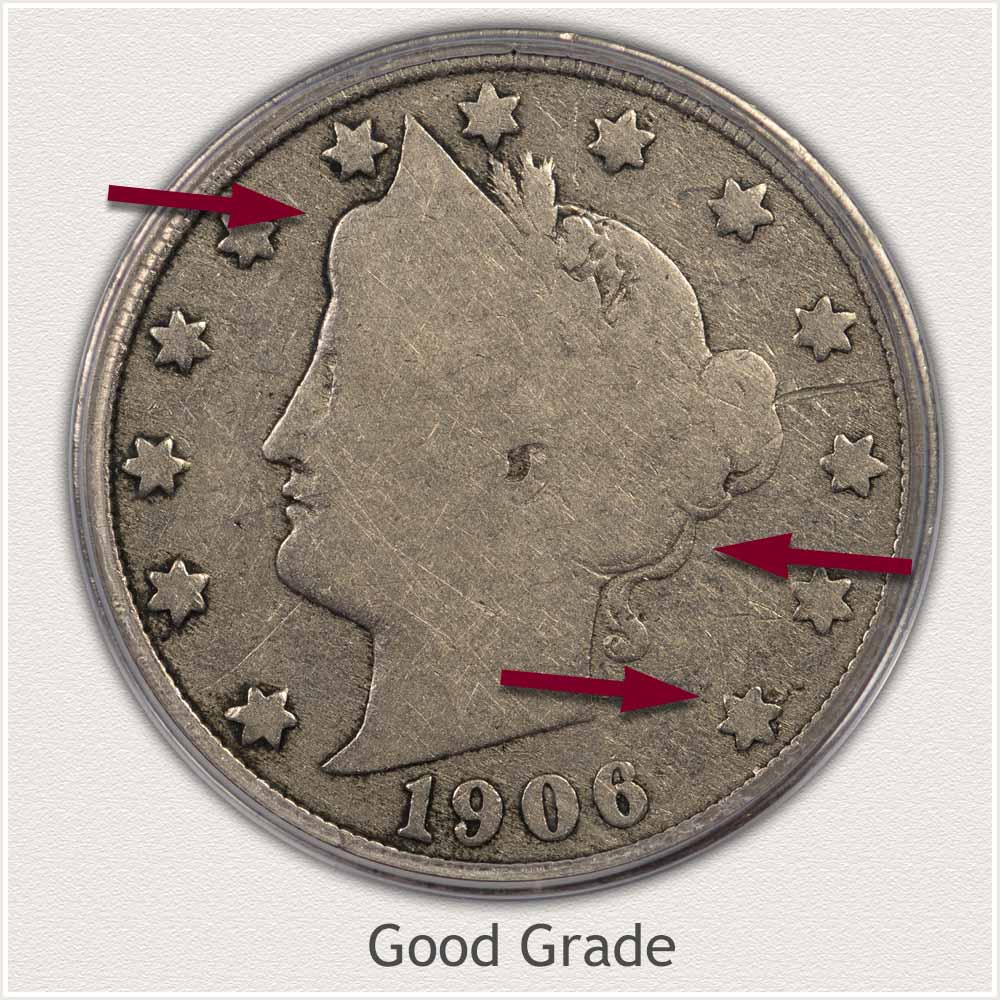
Good Grade: As the value chart indicates, a Good grade 1889 nickel is in demand. Heavy wear describes the condition; however, there are a few features required to meet the grade.
A full and complete outline of Liberty is verified first. Typically, towards the top of her head, she is very bold. It is at the back of her head that is often faded and merging with the field. Missing definition of the outline lowers the appeal and grade.
Thirteen stars frame Liberty, and all must remain fully outlined, and separate from the field. Weak stars fading into the field result in a missing major design feature. The example nickel also retains a complete inner edge to the rim, and all digits to the date are fully legible. Heavy wear does flatten minor details; however; major features are complete when a nickel is awarded the Good grade.
How to Video: Grading Liberty Nickels
Additional insight into the process of grading is found in the video. Also in the Liberty Nickel section are descriptions of both the obverse and reverse. Judging the complete coin further narrows the recognition of grade.
Grading Liberty Nickels | Visual Guides
Step 3: | Special Qualities | Subtle Points Double the Value
Features That Double 1889 Nickel Value
Values on the above chart point to a distinct rise - a doubling in value - from one level of condition to the next. Importantly, this change is due to design features either missing or present within the coin's state of preservation. A combination of pleasing appearance along with increasing details raises the appeal of these coins to collectors. Also, as values rise, differences from one category to the next become increasingly subtle.
 Close-Up Good to Fine Grade Differences
Close-Up Good to Fine Grade Differences
Easily visible is the large - greater than doubling - the amount of design appearing between a Good grade nickel and a Fine condition example. Worthy of a significant value increase is the moderately worn Fine grade nickel. Going from a featureless Liberty to one with an identifiable hair style, wreath, and headband. In contrast to a heavily worn coin, these moderately worn Liberty nickels are pleasing.
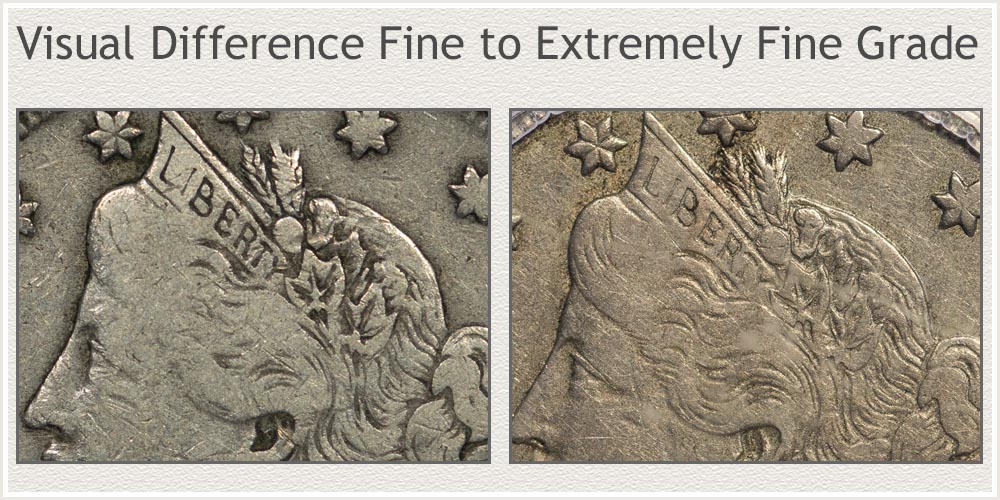 Close-Up Fine to Extremely Fine Grade Differences
Close-Up Fine to Extremely Fine Grade Differences
A closer look is required to detect the difference separating moderate to a light wear state of condition. Moving inwards towards the design; above Liberty's eye, an increasing amount of original design begins to show. A lightly worn nickel is characterized by the "sharpness" of the wreath, headband, and her hair style. Waves within the hair have gone from a "hint" to now mostly complete and unmistakable. Wheat and cotton within the wreath are recognizable, along with the boldness of the lettering across the headband.
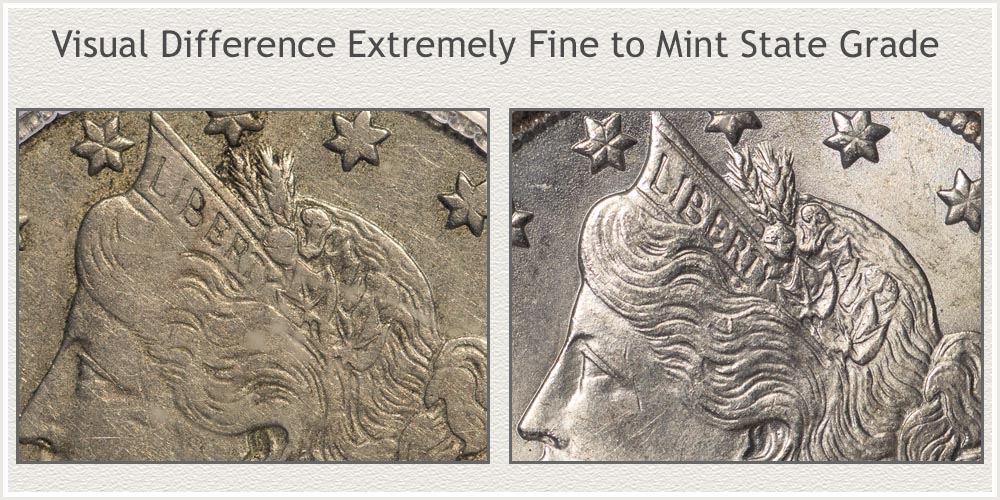 Close-Up Extremely Fine to Mint State Grade Differences
Close-Up Extremely Fine to Mint State Grade Differences
The next large increase in value relies on spotting very subtle features. At the top of the condition scale are coins without any wear, the Mint State grade. Because of the fine details and small areas of high points in the design, these wear points are increasingly harder to detect. Only a small amount of friction is required to wear the top edges of hair strands or wheat grains.
At this level of inspection, a comparison of the texture of the metal above and under Liberty's eye is also made. A small amount of smoothness is visible on the coin with wear. Next, compare the two headbands, wheat, and cotton details. These differences are small, however, account for a very large swing in value.
Major design elements remain in all above examples, portrait, rim, stars, and a bold date. As the designs begin to fill in with increasing amounts of smaller features, then major steps up the value scale take place. The inspection of these coins requires more time as they contain more detail.
References
U.S. Mint. 1890 U.S. Mint Annual Report
https://nnp.wustl.edu/library/book/315
U.S. Mint. Catalogue of Coins of the United States.
https://nnp.wustl.edu/library/book/554591
Coin Values | CoinStudy Articles
Date by Date
In Depth Liberty Nickel Values
1883 to 1912
The Value of V Nickels | A Series with a Wide Range in Rarity
Popularity of the Liberty design nickels is steady to growing. A value chart listing all dates and mints shows the demand for scarce issues and grades. Early years are rising in value, especially in higher collectible condition.
Old Nickel Values | Guide to the Different Nickel Series
1889 nickels, part of the Liberty series, is one of many different U.S. nickel series minted. Historically, the early years of the Liberty design are becoming highly valuable. Post Liberty are the popular Buffalo nickels followed by the varied Jefferson nickel issues.
Rare nickels are found in all the different design series. Five cent nickels, first introduced in 1866 with the Shield design, are an example of many scarce dates. Highlights include the Liberty, Buffalo, and Jefferson dates and mint varieties becoming difficult to find.
Coin Grading Services | Professional Judgement Provides Narrow Value Range
1886 nickels of high quality are premium examples, and scarce. Determining a market accepted grade is when Grading Services are used. Insights into the process of sending coins to the top two services.
★Coin Values Discovery finds 1889 Nickel Value and...
Charts covering Coin Values. The complete index page starts a step-by-step method introduced and followed to determine how much a box of old coins is worth. Using images along with descriptions, identify the various coin series and begin the next steps.
